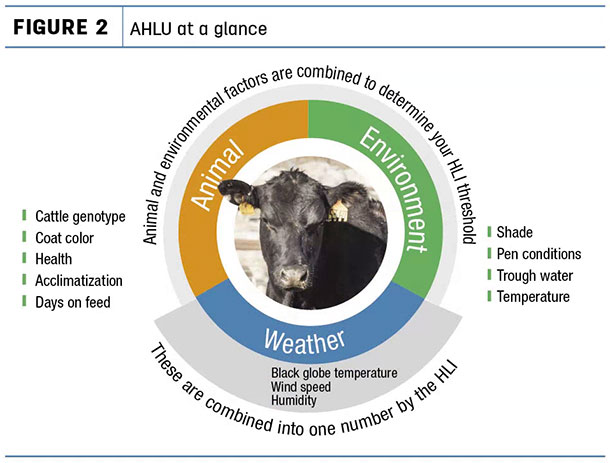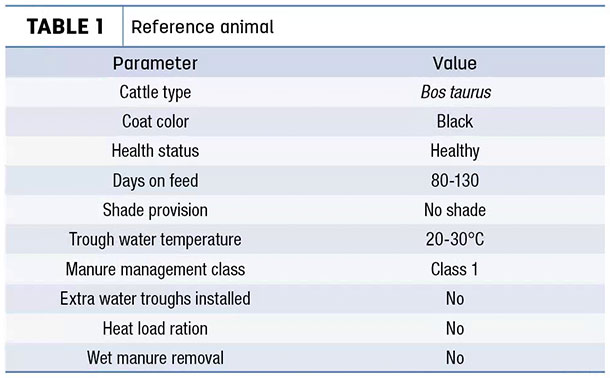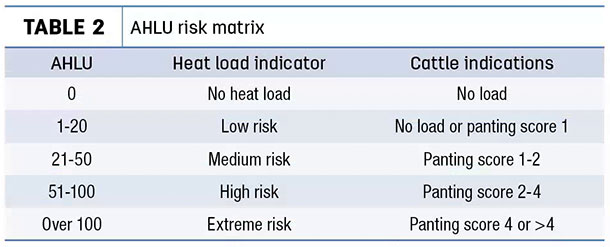Of these, the accumulation aspect is the most misunderstood.
Forgetting the science (to be addressed later in the article), think about it like this: A cast iron skillet is in the oven exposed to heat. Once removed, it still retains its heat for a period of time. Your cows, when exposed to heat, may do the same: retain a heat load for a period of time (Figure 1).

To manage heat stress, many producers rely on weather forecasts, current conditions, Temperature-Humidity Index (THI) and an observation of cattle behavior. Although useful, these practices do not include all four parameters of heat.
Extensive academic research created two advanced cattle-specific measurements to address current limitations: Heat Load Index (HLI) and Accumulated Heat Load Units (AHLU). We’ll explain each.
Heat Load Index
HLI, like THI, is a spot measurement of current conditions and can aid in the identification of current heat stress risk categories. It is different from THI in that it addresses solar radiation, wind speed and relative humidity in the calculation.
Accumulated Heat Load Units
AHLU is the most complete cattle heat stress model – addressing the fact cattle accumulate heat load during prolonged heat events when there isn’t sufficient environmental night cooling. THI and HLI alone may not predict the level of cattle heat stress because they do not address this accumulation impact.
We asked Dr. Tom Noffsinger, DVM, and Dr. Kev Sullivan of Production Animal Consultation to discuss why these measurements can best help determine heat stress level and what actions to take to protect your herd.
Q: What is the economic impact of heat stress to a beef producer?
A. Economic losses from heat stress can be due to mortalities from the immediate event but also from the subsequent health issues that occur in the recovery phase.
A significant decrease in performance occurs following reductions in feed intake, not just during the heat event but also due to the inability of the animals to return to the same feed intake occurring prior to the heat stress event.
Many animals never fully recover. Economic losses also occur from the health problems that inevitably occur after the heat stress event. These are rebound acidosis and respiratory disease outbreaks. Animals are fatigued after a heat load event, and it may take up to a week for their gut and muscles to repair. Downgraded carcasses are seen as a consequence of heat stress.
Q. Why do you recommend HLI and AHLU are used as measurements for monitoring heat stress in cattle?
A. HLI uses a combination of black globe temperature, relative humidity and wind speed. This index brings together these weather factors into one number to allow easy interpretation of the environmental heat load placed on cattle. The use of black globe temperature, rather than ambient air temperature, takes into account both air temperature and solar radiation.
The HLI is more appropriate to use in cattle not housed in barns because it considers solar radiation and wind speed when calculating the index. Proven to be a good indicator of physiological stress, the HLI has a minimum value of 50 and can reach as high as 130 in very hot, humid and calm conditions. Since it is an index, the HLI has no units.
The use of AHLU is very important, as this calculates the amount of heat stored in an animal (Figure 2). For each hour the HLI is above the HLI upper limit threshold, heat is stored in that animal and will remain stored until the HLI reaches a level at which cooling can occur and heat will be dissipated.

The AHLU calculates the amount of heat an animal has accumulated every hour as the day progresses. It also enables the producer to know how much heat animals are carrying over from the previous day after overnight cooling.
The use of this tool aids in helping the producer understand the severity of the heat stress event and make decisions on mitigation strategies before animals reach the point of heat accumulation where they can no longer be helped.
Q. How is AHLU calculated?
A. In order to calculate AHLU, an HLI upper limit threshold is determined. This is the HLI value above which cattle may start to accumulate heat. Academic research identified a reference animal defined in Table 1 and having an HLI upper limit threshold of 86.

Adjustments can be made to the list of parameters and will result in either a positive or negative correction to the HLI upper limit threshold. An accumulated heat load occurs whenever HLI exceeds the animal’s upper limit threshold.
Q. If a beef producer includes both HLI and AHLU in their heat stress management plan, how would you recommend they use them?
A. If a producer includes both the HLI and the AHLU in the heat stress management plan, they can use these as a risk management tool. Once the AHLU is calculated, the risk can be assessed using a simple AHLU risk matrix (Table 2).

Cattle will also tell you if they are carrying heat through panting. Cattle indications comparable to the AHLU are also included in the AHLU risk matrix.
Q. What are the most effective mitigation measures available to beef producers to minimize heat stress conditions?
A. There are a number of mitigation strategies that can help producers minimize heat stress. The implementation of these is often determined by the risk status. There are also some important preventative measures that can be taken. It is important to have clean pens. Manure depth should not be more than 4 inches.
Have a heat stress ration. Work with your nutritionist to have a feeding strategy to prevent a big drop in feed intake. Use extra water tanks in the pen. This will spread the cattle out and reduce the amount of bunching. Cooling the ground with the use of sprinklers will help cattle dissipate heat better and reduce crowding in wet areas of the pen.
Review cattle-handling processes during an event. It may be necessary to stop processing, re-implanting, pen moves, pen riding and even sometimes shipping if or when the indicator is high.
The use of shade is effective. There must be enough shade to be of benefit. The amount of shade needed is between 25 and 30 square feet per head. It is most important to develop a plan on what mitigations will be put in place and at what stage of the heat stress event.
Managing heat events and implementing the proper management plans can mean the difference between life and death of your cattle and send savings straight to your bottom line. With accurate microclimate environmental data and cattle-specific heat stress measurements, you will know when and where it is necessary to implement your plan. ![]()
Tom Noffsinger and Kev Sullivan are with Production Animal Consultation based in Oakley, Kansas. They can be reached at email above or by calling (785) 673-9572, or visit Nielsen-Kellerman for more information.







